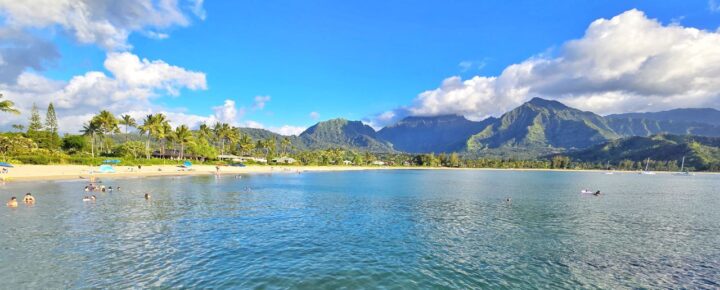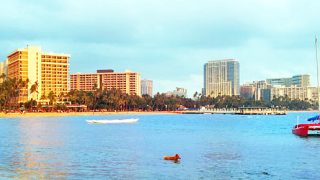For the first time in years, the state of Hawaii has funded its tourism marketing arm with a significant budget. This flames the ongoing debate about its usefulness and the potential impact on visitors. The legislature’s approval of a still relatively modest $60 million aims to support the efforts in promoting sustainable tourism and for managing Hawaii visitor impacts.
A financial boost comes amidst Hawaii marketing controversies.
This renewed funding is a relief for some, after a long period of financial instability for the Hawaii Tourism Authority. The agency has faced scrutiny and criticism for its management practices and transparency issues. Its newly allocated budget will be drawn from the state’s general funds.
Mufi Hannemann is the controversial figure at the helm of HTA. His appointment generated mixed reactions, with some praising Mufi’s extensive experience in Hawaii’s tourism industry and others questioning his past leadership decisions and connections with various stakeholders, most notably the hotel industry. While working for the state, he was also president and CEO of the Hawaii Lodging and Tourism Association, representing Hawaii hotel interests, on behalf of whom he has long lobbied.
Community and Hawaii visitors echo concerns.
Supporters argue that the renewed funding will help the beleaguered state organization enhance its latest focus on sustainable tourism practices and community engagement. The HTA’s most recent initiative, you’ll recall, is the very controversial Qurator certification program, which is said to highlight HTA’s commitment to promoting businesses that purport to demonstrate excellence in sustainable tourism.
However, there is skepticism about the HTA’s ability to manage funds effectively. Critics point to the agency’s troubled history and question whether the HTA can genuinely address the challenges associated with tourism, such as the decline in Hawaii visitors, exorbitant costs, questionable welcome, the vacation rental conundrum, environmental degradation, and the strain of tourism on communities. This is no small feat.
In addition, regarding Qurator, the inclusion of airlines including Alaska, Hawaiian, and Southwest, raises questions about the program’s authenticity and effectiveness in promoting genuinely sustainable practices. Critics argue that this initiative might be more about marketing hype than any actual sustainable impact, reflecting never-ending concerns about HTA’s transparency and management.
Balancing economic benefits and environmental protection.
The HTA’s budget approval underscores the importance of tourism to Hawaii’s economy. One Hawaii legislator, Senator Kurt Fevella, previously noted tourism’s significant contribution to state tax revenue and employment opportunities. Yet, he also was outspoken about the need for the HTA to focus on destination management and visitor education to protect cultural and natural resources.
The effectiveness of the latest funding will depend on how well the HTA can clearly and objectively balance competing interests. HTA’s ability to demonstrate tangible improvements in tourism management and development, plus community well-being, will be crucial in assessing whether the financial support translates into positive outcomes for Hawaii or is yet another Hawaii marketing boondoggle that could again lead to the state seeking to end the tourism authority.
The coming months will be critical in evaluating successes or failures under Mufi Hannemann’s hotel-centric leadership. The agency is yet to navigate the complexities of Hawaii tourism in relation to a myriad of seemingly conflicted interests. Those, of course, include Hawaii’s continued lackluster performance, and ensuring that travel remains a source of economic viability for the state, while also providing a sustainable and beneficial industry for Hawaii communities and the environment.
We welcome your thoughts.
Beat of Hawaii © photo at Hanalei Bay.
Get Breaking Hawaii Travel News






HI is really trying hard to convince tourists to go elsewhere. If tourism makes up 70 – 90% of taxes and jobs, it’s a great plan to reduce the number of tourists. Then add in the high cost of visiting HI, the high tourist taxes and plan to eliminate 24% STR, what could go wrong? Pretty soon you’ll get your wish. Of course no tourists means fewer jobs, reduced services and people moving to Vegas.
Perhaps one way to harness the spending conundrum is to make certain that their are clearly established goals supporting the environment, which coincides with Green initiatives. Make certain that all advertisers (hotels, airlines, etc.) fit the parameters established. Additionally, mandatory co-op programs be established for earmarked funds so the hotels, airlines, businesses have skin in the game.
Other states’ tourism entities are required by their state legislators to have a 1:1 match on all funds awarded.
Does HTA?
BOH. You’ve got something started here that could really explode (positively) if you could find a way to widen your footprint. Right now it feels like you’re “preaching to the choir”. I know you understand this. To make a real difference, your message has to get to the voters in a way that convinces them that it’s time to throw out most of the incumbent politicians in the state. It would seem that the major political party with the most gain needs to partner with you and use your followers and data to develop a platform and candidates that can convince the voters to act. I hope you are successful. It’s the only path. Go for it!
Oh yeah, I am in agreement with you 100%…..let’s roll BOH!!!
Aloha to all.
The Hawaii government increased property taxes for STVR 426% in 2023. No really, that is true. And the state gets 15.5% of every dollar of income on top of that.
All while bashing private citizens in the press and demonizing STVR owners.
Mufi…please, we are still stuck with his last great idea, rail.
“If you put the federal government in charge of the Sahara Desert in 5 years there will be a shortage of sand.”
Milton Friedman, American Economist, Nobel Memorial Prize in Economic Sciences.
Substitute Mufi Hannemann and Hawaii Government for “Federal Government” and Hawaii Tourism for “Sahara Desert” and, well, you get the idea!
Yup. Uncle Miltie had the right idea. Just as David Stockman so eloquently explained. Reduce the tax rate to zero, and the economy will take off. How’s that 1980 forward experiment worked? $7 trillion in deficits in DJT’s term alone after he slashed corporate. The only net neutral era was under Clinton. Even Stockman declared his own pronouncements a horrible mistake.
If you’re in the 1%, great idea. For the rest of us, not so much. Be careful what you wish for.
State taxpayers fund 60 million dollars promoting Hawaii tourism, so the Hotel industry can use more of it’s promotional budget to fund politicians who make their competion go away.
Typical government problem solving— throw money at it and hope it will somehow magically be fixed.
Excellent reporting BY BOH. Keep it up and continue to shine a bright light on this incompetent Hawaii government. Hawaii has got nothing but woke liberal special interest politicians at all levels of government who offer nothing but a word salad of psychobabel faculty lounge social engineering proposals and theories that are pie in the sky feel good liberal nonsensical ideas. While they talk and talk and talk, Hawaiians are unemployed and leaving their birthplace because these clowns have no common sense economic planning or fiscal management. The mainland born and educated governor would rather fly to Washington DC to prop up the failing President than stay in Hawaii and work on these serious economic issues facing the people of Hawaii.
Very sad for all residents and tourists alike.
The hubris and ignorance is astounding. No other states attempt to tell their visitors how to behave on vacation there beyond customary speed limits, safety warnings and park rules. People go on vacation to relax. Most vacationers will be sensitive and caring of the land and the people. Trying to control the uncontrollable is a fools errand that has already turned off many long-term, sensitive Hawaii visitors. Wake up and look at the empty lodging and sparse tourists at local restaurants and other businesses they used to frequent. The last few months have been terrible.
But no worries. The pandering to Hawaii for Hawaiians sells- enough to cover for the mismanagement of housing affordability and divert attention from the gross dereliction that contributed to and made the fire disasters worse.
Aloha nui loa!
Did you know? 95% of the world’s tourists flock to just 5% of its land area. This places a huge strain on a select number of popular tourist locations.These states, including most coastal areas, in fact do put restrictions on use patterns, eco-sensitive areas.
Please know that it’s not “hubris”. It’s recognition that without placing these use restrictions, the primary reason that tourists visit will no longer exist. With warming ocean waters combined with over-tourism. Here in Kona town on Hawaii Island Kahalu’u Beach Park was closed for an entire month for coral spawn. Without that closure, sensitive polyps would have been exposed to improper sunscreens, coral trampling (intentional or not), etc.
HTA is promoting responsible tourism. It can’t mandate behavior.
In January 2024, Hawaii saw a decline in both visitor arrivals (763,480 visitors, -3.6%) and spending ($1.81 billion, -4.5%) compared to January 2023. However, spending was up 11.9% from January 2019.
Managing Hawaii Tourist Impacts. What’s this damage done by tourists. Whats the plan. Impose more citations, fines, and track the tourists every move after leaving the hotel. The state keeps increasing the cost for visitors and now wants to invest 60 million in promoting sustainable tourism. What’s this plan? Sorry none of this makes sense to me. Is this an apology or a slap in the face? Less tourist’s isn’t even sustaining it’s losing tourists.
BOH: really appreciate your continued focus on reporting these issues. It’s a huge issue that affects everyone on the islands, and you do a great job showing the multiple points of view.
As for Mufi and his motivations … it is impossible to imagine that he has any concern for any aspect of Hawaii except occupancy rates in hotels. His conflict of interest is damning and irrefutable. Tourism is complicated but essential … and biased interests like HTA are not here to help; only to profit.
Tourism is indispensable to the islands, and it can be managed for the best interests of travelers + STVRs + local businesses + Hawaii people. But not by liars whose interests are not focused on Hawaii. It is finally time to stop giving “equal time” to dishonest people and to call out the obvious motives.
Even though we have been to Hawaii many times over the years and have always respected the land and the people. We are saddened by the unwelcome feeling we get now. Having to book ahead to go to beaches is not appealing. Part of the fun was spur of the moment decisions and changes if there was a downpour. None of it says relaxing or fun. We are headed to Tahiti where we are welcomed with open arms and totally enjoy ourselves.
Don’t make sense to spend a bunch of money on advertising and promotions. Take the 60 million and disperse it among a set of affordable restaurants and hotels and in turn the hotel will grant a 20 percent discount to the tourist. Promote incentives for tourist’s discounts and sales. Maybe offer a Hawaii discount travel coupon book with special hotel stays and 2 for 1 discounts.
Hotels? That 20% discount won’t go very far. Average, that’s Average, nightly rate is now $419. Factor out the bedbugs and Legionnaires cases (think Hilton!), and I’ll take a cleaned-right-before-I-visit-for-half-that-amount AirBnb. BTW, who’s going to advertise your program if not HTA?
Make it an incentive with the booking partner. Expedia,Travelocity,Priceline, Costco, Orbitz, Kayak, and the airline Vacation bookings. Hawaii used to have the Hawaii Entertainment Book with 2 for 1 coupons. Hotel deals with selected properties etc. Make it a bonus when booking your next Hawaiian vacation and for Hotels select apply entertainment coupon when booking. Sorry 60 million probably wouldn’t go far if the discounts were really 50% off on hotel stays.
James
Who knows who will advertise. Honolulu Star, Travel sites, For HTA the situation might be for desperate times you have to take desperate measures. Only time will tell.
You don’t have to be a rocket scientist to figure out what HTA’s intentions are. Make it even harder for the middle class to consider vacationing in Hawaii and hope only the ‘Elite’ continue to visit. With the disappearing STR option and the exorbitant price increases, they may just get what they hope for. Unfortunately, to believe that the ‘entitled’ money bags are going to be more environmentally and culturally observant is a pipe dream. Mufi and his hotel homies will be the beneficiaries and the Hawaiian people the disadvantaged.
Waiting to see a “real” explanation of exactly what “sustainable tourism” is that does Not drive visitors to Hawaii only in hotels with their exorbitant costs for literally everything! I have stayed almost exclusively in condos during my 38 trips to the Islands and I sure as heck will not be changing that. To be quite frankly, almost all of Hawaii’s problems come from within the government and right now your governor is definitely at the top of the list as to where the problems lie!
All for sustainable and environmental tourism. As for Mufi/HTLA and HTA co-existence, let’s wait and see where the HTA budget goes when STVRs across all islands get their collective haircuts under the new authority to regulate and tax revenue tanks.
Spending by short-term rental visitors in 2023 generated an estimated $554 million in General Excise Tax (“GET”) and Transient Accommodations Tax (“TAT”). Of the $675 million total, $554 million was tax revenue for the State of Hawaii, while the county surcharges to the GET and TAT generated an estimated $121 million for the rest of the counties.